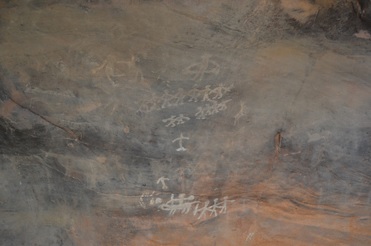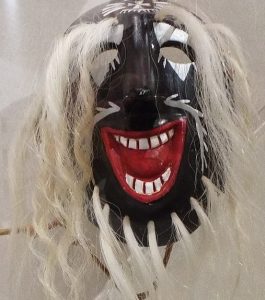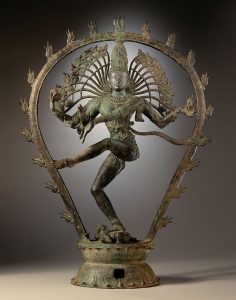3 Religious Dance
What is Religious Dance?
The earliest dances were likely tied to religion, using movement as part of rituals. Belief systems embraced dance as a way to connect to higher powers that influenced everyday life. Other religions eschewed dance or banned it for several different reasons. “Religious” can refer to a range of ecclesiastic-ism. Primitive imitative dances and dances to the elements like the sun and rain appealed to nature and the spirits whose benevolence made existence possible. Some dances are indigenous, but others have traveled, morphed, and adapted from earlier roots. By studying religious dance, you gain insight into the worship of different cultures.

Rock Shelters of Bhimbetka
The Rock Shelters of Bhimbetka are in the foothills of the Vindhyan Mountains on the southern edge of the central Indian plateau. Within massive sandstone outcrops, above comparatively dense forest, are five clusters of natural rock shelters, displaying paintings that appear to date from the Mesolithic Period right through to the historical period. The cultural traditions of the inhabitants of the twenty-one villages adjacent to the site bear a strong resemblance to those represented in the rock paintings.
Description is available under license CC-BY-SA IGO 3.0
This file is licensed under the Creative Commons Attribution-Share Alike 4.0 International license.
Our understanding of Ancient Greek dance is based on artwork of the time accounts written by Greek scholars
Processionals and Round Dances
Ancient Greek dance was used to solidify the community and was divinely inspired. Everyone participated in religious ceremonies as cultivated amateurs and well-rounded citizens. A big part of the program was processions and circle dances. The realities of the cosmos ruled the symbolism of the dances and references to the sun, moon, and constellations figured into the movement. In Greek Mythology, the nine Muses are goddesses of the Arts, born of Zeus and Mnemosyne, the goddess of memory. Of them, Terpsichore is the Muse of dance, often represented holding a lyre.
Dance in Ancient Greece can be divided into two types: Dionysian dance and Apollonian dance. The god Apollo was was the Patron of dance, music, philosophy, and healing. He was associated with Light. Apollonian art is known for serene majesty and formal balance.
Dionysus, on the other hand, was the god of fertility, wine, and dance. His divine power induced cheerful merriment and wildness. Dionysian art is known for unrestrained emotion and ecstasy.
The Dithyramb was a chorus that was incorporated into ritual festivals with choric song and dance, accompanied by flute. They were an effort to control the wild dances of Dionysus. They evolved over time to become “tragedies,” what we consider the origin of Western theater. Thespis was a dithyramb leader from the 6th century BC who is credited as being the first actor in the Western world and to this day actors are known as thespians.
Types of Religious Dance
Religious dances can be categorized by their purpose as:
- Dances of Imitation
- Medicine Dances
- Commemorative Dances
- Dances for Spiritual Connection
DANCES OF IMITATION
Particularly in primitive and indigenous cultures, dances of imitation are performed. The dances can serve all kinds of purposes, often in search of fortunate outcomes like good weather and good hunting.
Watch This
Native American: Sioux Buffalo Dance. In this video filmed by Thomas Edison in 1894, men from a Sioux tribe imitate a buffalo in tribute to its courage. They bend forward from the waist, performing knee-raising steps as they move in a circle.
Native American: Eagle Dance
The Eagle Dance is performed to connect with a higher power for healing, rain, strength in war and general divine intervention. It is often performed by two dancers with drummers surrounding them. The dancer dons feathered wings that he spreads and flaps in imitation of the great eagle. He does a low skip, lifting his knees high, moving in a serpentine pattern. Then he pauses, perches low, and folds his wings over his quivering leg.
Watch This
Sierra Leone: Ostrich Dance
A Jacob's Pillow program note for this Ostrich Dance delineates its cultural importance: “Warriors imitate the powerful graceful movement of the king of birds. Living close to nature, they observe the movements of the ostrich, the largest and most powerful of the birds on the continent of Africa. This dance, from Sierra Leone, was introduced in the United States by Asadata Dafora.”
Watch This
Asadata Dafora was a privileged and well-educated Creole man from Sierra Leone. He was determined to educate the rest of the world about African culture. He traveled Western Africa learning its dance, music and stories, then shared these arts with the rest of the world. In the 1930’s he brought African performance arts to the American theatrical stage.
Australian Aboriginal Dance
Australian Aboriginal dance commonly incorporates imitations of certain animals or birds to assist in storytelling and to bring dreamtime to the people. Dreamtime refers to the ancestral beings associated with life force and creative power who they believed could communicate important messages or life lessons though one’s dreams.
Their traditional and ceremonial dances could be used as an initiation process or to celebrate a new stage of life. Dances played an important role in the spirituality of Indigenous Australian tribes and each group had different customs when it came to performing and orchestrating these dances.
Watch This
The Aboriginal Crane Dance
Mexico: Yaqui Deer Dance

The Yaqui people of Sonora, Mexico and Arizona.
This hunters’ dance imitates the movements of the prey and reenacts the hunt. Deer dancing is related to three of the nine “worlds” that Yoemem (the Yaqui people) recognize. This dance, like the religion, centers on balancing the worlds and repairing harm done to them by humans. Catholicism was introduced to the Yaqui by Jesuit missionaries, and today most practice a syncretic religion that is a merger of the two.
Watch This
MEDICINE DANCES
San Tribe of Africa (Bushmen Dance): The trance dance, which is still practiced by San communities in the Kalahari region, is an indigenous ritual by which a state of altered consciousness is achieved through rhythmic dancing and hyperventilation. It is used for healing sickness in individuals and healing negative aspects of the community as a whole.
Watch This
Trance Dance
Amazon Indigenous People: Bullet Ant Coming of Age Ritual. Young men test their endurance by wearing a glove full of stinging bullet ants. Men of the village join the young man in dance to help survive the pain.
Watch This
Mongolia: Shaman Dance
In Mongolia, Shamans serve as intermediaries between the human world and the spirit world. Both men and women may be Shaman. The religion is animistic (attributes a spirit to all things), and rituals address medicine, religion, a reverence for nature, and ancestor worship. On the summer solstice Shamans perform a fire ritual at night. The Shaman drums carry the ancestral spirits of the Shaman.
Watch This
Mongolia: Shaman Dance, a performance at Ulan Bator’s Choijin Lama Temple Museum.
COMMEMORATIVE DANCES
Dances are created to remember a special day, a special event, a meaningful moment. Some commemorative dances are very old. Maypole dances have early pagan roots. It is a celebration of the rebirth of spring. Other commemorative dances are more recent and more personal to our times.
China: Dragon Dance
In China, the dragon is a symbol of imperial power and good luck. It follows that the longer the dragon, the better the luck. In particular the dragon dance is performed at festive occasions, especially the Chinese New Year. Dragons are often about 100 feet long, although they also can be shorter or even twice as long. The dragon is traditionally constructed with fabric laid over hoops that are lifted over the performers’ heads on long poles. Performers must coordinate their movements to achieve the sinuous dance of the dragon. Nine is a standard number of dragon dancers but it can be less or more. Some dragons even specialize with fancy patterns and acrobatic feats.
Watch This
United States: 9/11 Table of Silence Project
performance ritual and call to action for peace
Presented by Lincoln Center in partnership with Buglisi Dance Theatre
A PROJECT OF THE ARNHOLD DANCE INNOVATION FUND
Ten years after the World Trade Center and the Pentagon were struck by a terrorist attack on September 11, 2001, this commemorative dance was created. Performed each year in the heart of New York City at Lincoln Center for Performing Arts, dancers from all over the city join together to remember those who lost their lives on that day and the first responders who died in the days after.
Dancers from many different religions participate in this dance. It is for all to reflect and remember, regardless of personal creed. Dancers from all over New York City audition to participate in this dance. Rehearsals are held in a number of spots throughout the city beginning months in advance, then the groups come together to dance on the day and time of the anniversary of the attack.
This dance is reminiscent of the style of Ancient Greek dance. It features a procession into the Lincoln Center plaza. Dancers keep time with their strides, proceeding in a circle as they perform meaningful gestures in unison. They position themselves in concentric circles and continue to dance together in unity. This is a dance that brings the community together to remember a tragic time in American history.
Watch This
American Apache: Girl’s Rite of Passage
“Apache girls take part in ancient tests of strength, endurance and character that will make them women and prepare them for the trials of womanhood.”
Watch This
DANCES FOR SPIRITUAL CONNECTION
Christian Dance
The holy book of Christendom (and Judaism) is the Bible. References to dance can be found peppered throughout, especially in the Old Testament, and dance was a part of early Christian ritual. However, the Church came to equate dance with the desires of the flesh and loosening of mores, and dance was banned from church ritual. Some religious groups, Calvinists and Quakers, completely banned dance from their lives. Christianity is the only major world religion that has forbidden dance to such an extent.
During the 1960’s the Catholic pope called the Second Vatican Counsel. At that time the liturgy, the rituals of the church that parishioners participate in, was updated to reflect the times. Dance found its way back into the church. Several other groups restored dance to their services. Some Protestant churches participated in ecstatic worship in which worshipers would talk in tongues and shake or roll in the ecstasy of the holy spirit.
The Charismatic Movement of the 1970’s ushered the Christian church into contemporary times, and dance found new purchase in the form of liturgical dance, or praise dance. Worshipers combine dance and music to express the spirit of God.
Watch This
My Worship Is For Real | Anointed Praise Dance Ministry
The early Christian church developed the notion of the afterlife, which led to purity on earth. To achieve that purity, a life of celibacy was ascribed. Dance, especially dance between sexes, was eschewed. The Catholic church under Pope Gregory went further to banish dance. Even as citizens were dancing at festivals, guild meetings, and court balls, the church of Rome denied dance.
In 1604 England also banned dance in the church. The “Shaking Quakers” incorporated ecstatic dance into religious services. The sect moved to the United States as groups of “Shakers,” a religion restricting interaction between men and women. The parishioners would dance, sing, and shake out the sins of the flesh in their worship. In 1930, the first generation modern choreographer Doris Humphrey choreographed “The Shakers,” depicting scenes of the Shaker worship experience. This clip shows a portion of the dance.
Watch This
The Shakers
Cultural Connections
Gene Kim and faith based dance series on InstaGram.
Recent alum Gene Kim creates faith-based dance video series for Instagram
Pursuit of Vitality.
Dancer Personifies Gospel Music.
Damascus – Islam: Sufi “Whirling” Dervishes
The Mevlevi sect of Sufi Islam has practiced a dance for over seven hundred years based on the writings of the poet Rumi. The dervishes spin faster and faster, chanting Allah, with the right palm lifted to heaven to receive God’s blessing and the left hand pointing to the ground in a terrestrial connection, the Dervish existing between two worlds. The dancers seek to suppress their ego to find oneness with God. The ceremony is called a sema. It is especially practiced in Turkey.
Watch This
India: Bharatanatyam

Shiva is one of the principal gods of Hinduism. He is recognized as the god of dance and creator of the world.
Bharata Natyam is a very old religious dance performed in India by women. Early religious stories are told through hand gestures, facial expressions, and rhythmic foot drumming. Young girls called devadasis were committed to God and trained to perform the Bharata Natyam in church, but they were exploited and ultimately used as little more than prostitutes. Under the British colonial Raj rule, the Bharata Natyam was banished. Some influential Indians helped to preserve the dance.
Watch This
Japan: Bugaku
Bugaku is a Japanese classical dance rooted in ancient Shinto ceremonies tied to the rituals of the Imperial Court. Men perform it exclusively, telling stories, legends, or battles to educate people about religious beliefs. The purpose of Bugaku is to appease the gods, purify evil spirits, and pray for favorable outcomes such as a good harvest.
The movement used in Bugaku is sacred and symbolic. One unique feature of Bugaku is the stylized walking, known as “the art of walking.” Performers are trained to keep the feet connected to the earth through slow, precise, and deliberate movement, known as Okisa. Okisa is the energy that generates and flows from within the performer’s body for spiritual connection.
Watch This
Cambodia: Robam Boran
Cambodia’s Robam Boran, also known as Khmer classical dance, is one of Southeast Asia’s oldest court dance traditions. Initially, the king’s lakhon lueng, sacred female dancers, ritualistically performed dances to pray to ancestral spirits for favorable outcomes, such as rainfall.
Training in Roban Boran begins at an early age. Children’s bodies were manipulated by their teachers to make them flexible. Performers’ fingers and toes curl back, and the elbows are hyperextended. Dancers also are expected to hold their balance for an extended period. Robam Boran uses stylized movements and gestures to convey a story. The gestures are called kbach and are symbolic of nature, such as a flower, leaf, fruit, or tendril.
Watch This
The Magic of Khmer Classical Dance
Hawaii: Hula
The Hawaiian People practiced a polytheistic religion with four primary gods and numerous undergods and spirits. There was a kinship between the gods and the ruling class, and indeed, all people were on a more equal footing with their gods than in traditional Western religions. There was no written language for Hawaii, so it was through the practice of the hula dance that the lore of the people was preserved and passed down to following generations.
Watch This
Hula Is More Than a Dance—It’s the ‘Heartbeat’ of the Hawaiian People.
Ghana, West Africa: Voodoo Dance and Music Celebration
Voodoo primarily originated in Western Africa and was then transported west with the African diaspora to take root at points in South America, the Caribbean Islands, and North America (New Orleans in particular). Different versions of the practice emerged at these diverse locations, and syncretic versions (the blending of different belief systems) of the original practices developed to incorporate ideas from the Catholic church. Voodoo recognizes divine spirits that govern the Earth, its natural forces, and its people. These spirits are the center of religious practice. Voodoo practices ancestor worship, and holds that the spirits of the dead are living among us.
Watch This
First peoples; the earliest known inhabitants of a region
The Greek muse of dance.
An artistic style of passion, emotion, and abandon. This is an eponym for the Greek god of wine, Dionysus.
An artistic style of balance, light, serenity. This is an eponym for the Greek god of light, dance, and knowledge, Apollo.
An actor. This is an eponym for the Ancient Greek credited as the first actor.
Begun by Ted Shawn on donated land; a pre-eminent dance retreat in America's Berkshire mountains
characterized or brought about by a combination of different forms of belief or practice
An arts complex with 30 venues that is home to NYC opera, ballet, symphony and more


